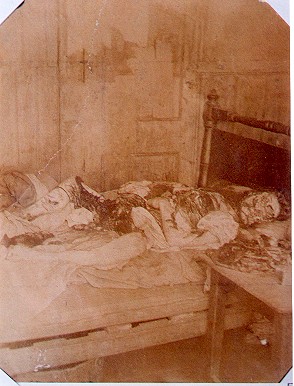I've kept a journal filled with notes from the various resources I've used. In it, I've recorded facts, quotes, evaluations on the work and author, and my own conclusions from all the research. Dr. Lamb suggests students keep a writing guide, which is what I decided to do. Furthermore, by recording my reactions and feelings to my research findings, I feel I have developed a better and richer depth of knowledge regarding Ripper's many theories. My thoughts in my journal allowed me to not only record facts and quotes, but gave me ample space to focus on questions that came about from reading resources, or emotions and feelings prompted by visual resources, such as viewing the Ripper's letters and victims' bodies at http://www.casebook.org/ripper_letters/ and http://www.casebook.org/victims/. These resources reinforced what I learned from my visual literacy trailblazer assignment and allowed me to get a better feel for the environmental, social, and historical time period.

***Mary Kelly as she was found in her bed at 13 Miller's Court (from http://www.casebook.org/victims/mary_jane_kelly.html)
This is photograph of Mary Kelly, the Ripper's supposed last victim. Just examining this visual sparked my "wiggling" with more questions and uncertainties. Did the Ripper leave her in a certain position because he knew her; was the more violent mutilation of Mary Kelly compared to the other victims supposed to be an indicator or clue for who Jack the Ripper was? Other thoughts that came about because of this website and it's visuals started me thinking about forensic science, criminal profiling, and serial killers' motives. I guess I could do another blog on just profiling the Ripper based on the arrangement of the victims' bodies and his handwriting style in his infamous letters. For a high school student, visual literacy can create and foster more curiosities and questions, as I just demonstrated above. As a media specialist, I would encourage students coming to me for research help to consult visual literacy sources such as photos, audio clips, and virtual online activities. This concept, as I discovered and wrote about in my trailblazer assignment, can stir students' interest more than just reading from their course's textbook or taking notes based on the "lecture-chalkboard" syndrome.
The next important part of "wiggling" is skimming and scanning. As described above, I used the casebook.org web site's links on the side of the page to guide my research process. This provided me with some important background information and helped me develop an outline of how I would arrange my ideas and findings in my final project. In addition, these links provided me with additional sources of information, such as dissertations and discussion/message boards to consult. These links proved helpful and informative in guiding my research and causing me to return back to my previous topic angle to alter my focus. Furthermore, these links are wonderful sources for students to use, much like the bibliographies listed in printed works. Students should be encourage to "wiggle" and roam freely with their inquiries through skimming various online links and bibliographies/webliographies.
"Journaling" is an excellent tool for anyone, including students, to incorporate into their research project. I found I not only had a better grasp of my topic, but I more readily developed questions and issues I had not thought of -- like examining artwork for visual clues to Jack the Ripper's motives. Overall, I agree with Daniel Callison's finding when he commented, "Students begin to generate their own questions in a personal journal and expand this list as they engage in more reading, viewing, and small group discussions" (180).
****************************************************************************
Works Cited
Callison, Daniel. The Blue Book On Information Age Inquiry, Instruction and Literacy. Westport, CT: Libraries Unlimited, 2006.
Lamb, Annette. "Wiggling." http://virtualinquiry.com/inquiry/wiggling.htm


No comments:
Post a Comment